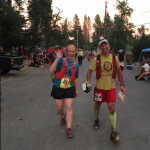Let There Be Light!
| November 24, 2019 | Posted by Melinda under Uncategorized |
Mistakes during ultras boil down into big ones, small ones, and unlucky ones.
The unlucky ones we can’t do anything about. So sorry, that’s how the game is played. You fell, busted your shin, broke 2 fingers. You stopped and helped a fellow runner that dislocated their knee cap and it was the right thing to do. You shrug, smile and sigh. Better luck next time.
There’s small mistakes, if anything can be considered small over the course of a 100k or 100 miler. Small things not corrected can turn into big things, but most of the time if you correct them fast enough, no harm done overall. Maybe there’s an extra blister on a toe and a couple of minutes lost because you had to stop and fix a wrinkle in your sock that you didn’t manage carefully enough the morning of the start. Or maybe there’s a small hot spot on your shoulder-blade that’s annoying because you forgot to make sure your shirt collar was pulled up high enough and the vest rubbed before you could correct them. None of them are race ending, and they are fixable if you are inclined.
Then there’s the big mistakes that are difficult or impossible to recover from.
Let me tell you what two of them are.
- Going out too fast.
- Bungling up your light source for races like 100k’s and 100 miler’s where you will be spending several hours (at least) after dark.
I’m not going to belabor the point of number one. You’ve been warned not to do it. You’ve done it, I’ve done it, we’ve paid the consequences. Just. Don’t. Do. It.
Let’s move onto having a light source, or in the case of the bungle up, not having a light source.
Unlike horse endurance rides (EN_October2019), running ultras depends on your own two (or in my case one….) eyeballs.
Last time I checked us humans don’t possess a tapetum lucidum or any of the other nifty adaptations that would allow up to prowl up and down run the trails in the dark.
We need light.
Every time I run a race with night running I see runners race’s that are going horribly wrong because somehow they end up on the trail without a light source. Here are some of the scenarios I’ve actually seen occur on race day.
Battery or Recharge Life Shorter Than Anticipated
The stats on your headlamp lie. Any prior experience you’ve had with the headlamp is a lie. Maybe it’s because the temps are cooler on the trail and that affects how fast the battery drains. Maybe all those early morning or late evening runs in the dark that you did on a single set of batteries or a single charge aren’t actually adding up to the hours you think. Maybe your eyes are more tired on the trail at night so you end up using a higher setting.
I don’t know the exact reason why, but I do know that if you don’t have spare batteries or a spare headlamp while you recharge your other one, YOU WILL END UP IN THE DARK. It’s just a fact. Which brings us directly to our next error, as they often go hand-in-hand.
Bringing a Single light Source
Think about what you are risking when you take a single light source with a single set of batteries into the night, intending on running several hours in the darkness. You are saying “I’m so confident that nothing is going to go wrong that I have zero back up.”
Ummmm no. Just no.
A single light source is the number one reason I see people in total darkness, fumbling their way down the trail, their iPhone batteries long since dead as they resorted to using their flashlight app after their single light source broke/ran out of charge/ran out of batteries.
Even leaving aside the time suck that goes into slowing your pace dramatically without a light, and discounting the inherent risk that comes with tripping your way through a technical trail without moonlight to help you along, what really really sucks is the mental exertion and fatigue that occurs when you have to work that hard without a light. In a longer ultra when the mental game is the game, this can be the difference between a finish and a DNF, even if you have time to spare.
I regularly hear runners asking the first night aid station whether anyone has a spare headlamp or light source that they can continue the run with. It’s heart-breaking because usually the answer is no. Pairing up with another runner that does have a light can work in a pinch, but depending on how technical the trail is and other factors, that may or may not be a viable solution.
There’s a very simple solution to these problems. ALWAYS bring a secondary light source. ALWAYS assume you will need more than one set of batteries or more than one charge for any night running that lasts for more than one hour.
Depending on Crew or a Drop Bag
It’s really inconvenient to carry a light all day. Why not just give it to your crew, or put in the appropriate drop bag?
Because when it comes to items that can make or break your race, you should leave very little to chance.
My very first 50 mile race was late in the season and the days were short. There was going to be several hours spent running in the dark. The aid station prior to it actually getting dark (for us back of the packers) had a drop bag.
Or at least, was supposed to have a drop bag.
It was an aid station that we had passed through in the early miles of the race, and the drop bags were there. And then, suddenly, when we were there as our last stop before the sun fell, the drop bags were no longer there.
Someone, probably confused because there were numerous distances occurring at the race, had picked up the drop bags and taken them back to the finish well before the cut offs, and well before the back of the packers had made it through the aid station.
It was inconvenient. I had a jacket in there I would have really liked to have worn. For the person I was running with it was devastating – her head lamp was in that drop bag.
Yes, race management made a mistake and the drop bag should have been there. But it wasn’t. You can complain and gripe and send lots of emails after the race, but at the at the time, what are you going to do? In this woman’s case someone was able to give her a headlamp to finish the race out with, that had a ginormous headband they couldn’t get to fit on her head, so they fashioned it into a waist lamp. Yay!!!!!
But.
That’s why I don’t put all my eggs in one basket.
If I give my headlamp to my crew to give to me at the appropriate aid station, there’s also one in my drop bag – just in case. Chances are one of the two will make it to the aid station. But truthfully, I believe in not giving fate even a crack, so I carry a tiny flashlight with a spare battery in one of the pockets of my race vest. It’s tiny, weighs nothing, takes up no space. It’s a small price to pay for something that may save my race some day.
Here’s the basic take aways
- ALWAYS plan for worst case scenario. Don’t assume your crew is going to make it at the most critical time with the most critical gear. Have backups available. It wouldn’t be fun to run for hours and hours with my little handheld flash light, but it would be doable.
- ALWAYS carry two light sources at night. In addition to being prepared when one breaks unexpectedly, it’s very useful to have a second light when having to change batteries in your other light!
- If you are going to be doing substantial night running in an upcoming race, it will be very beneficial to go on a long night run to test out your lighting system. This is where most people discover that their lights have a shorter battery life than anticipated and can make adjustments.
- ALWAYS bring a spare power source for your light sources. Manufacturer’s ratings are often based on running the light on its dimmest setting, and running it until the light goes completely dark, in an “ideal” temperature. A lot of lights will dim as the battery gets lower. It can make it hard to see trail obstacles, so often you end up changing the batteries out before they are truly dead. Even a slight dimming can affect how well you see on a technical trail.
- Your cell phone is not a secondary light source. It’s amazing just how fast a phone battery will go dead when using it as a flashlight, especially in cool temps.
- Your pacer’s light source isn’t your secondary light source. I can recall several instances where I’ve seen both runner and pacer making their way in the dark because both of their lights failed.
- Technical trails at night need brighter light to navigate them at a quick speed than jeep roads. Plan on extra battery changes if running technical trails late in your race after dark.
- Don’t rely on the moon. When you light fails it either won’t be in the sky, won’t be at the right phase, or is going to be covered up with trees. You’ve been warned.
- If putting your light in a drop bag, stash it at the aid station that you are guaranteed to hit in the daylight, even if your entire race is going to sh*t and you are barely above the cut offs. A common mistake is to put your light at an aid station that you plan on getting to before dark, only to drop behind pace and not quite make it.
Having a light is the easiest big problem you can solve at an ultra.
Of course, you know what’s going to happen now right? Now that I’ve written a post on how this is impossible to get wrong with a bit of planning, the fates will deliver a giant helping of humility at my next 100 miler (69 days) and I will get to write a blog post about how it feels to grope through the woods blind for hours. Let’s hope not!












